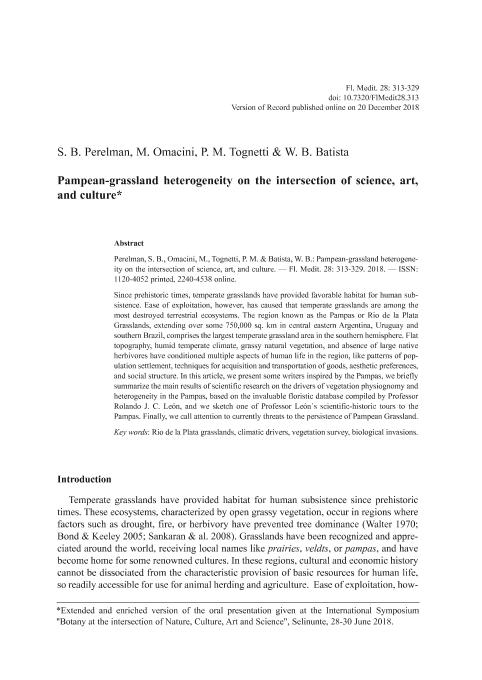Artículo
Pampean-grassland heterogeneity on the intersection of science, art, and culture
Fecha de publicación:
12/2018
Editorial:
Fondazione Internazionale pro Herbario Mediterraneo
Revista:
Flora Mediterranea
ISSN:
1120-4052
e-ISSN:
2240-4538
Idioma:
Inglés
Tipo de recurso:
Artículo publicado
Clasificación temática:
Resumen
Since prehistoric times, temperate grasslands have provided favorable habitat for human subsistence. Ease of exploitation, however, has caused that temperate grasslands are among the most destroyed terrestrial ecosystems. The region known as the Pampas or Rio de la PlataGrasslands, extending over some 750,000 sq. km in central eastern Argentina, Uruguay and southern Brazil, comprises the largest temperate grassland area in the southern hemisphere. Flat topography, humid temperate climate, grassy natural vegetation, and absence of large native herbivores have conditioned multiple aspects of human life in the region, like patterns of population settlement, techniques for acquisition and transportation of goods, aesthetic preferences, and social structure. In this article, we present some writers inspired by the Pampas, we briefly summarize the main results of scientific research on the drivers of vegetation physiognomy and heterogeneity in the Pampas, based on the invaluable floristic database compiled by Professor Rolando J. C. León, and we sketch one of Professor León´s scientific-historic tours to the Pampas. Finally, we call attention to currently threats to the persistence of Pampean Grassland.
Archivos asociados
Licencia
Identificadores
Colecciones
Articulos(IFEVA)
Articulos de INST.D/INV.FISIOLOGICAS Y ECO.VINCULADAS A L/AGRIC
Articulos de INST.D/INV.FISIOLOGICAS Y ECO.VINCULADAS A L/AGRIC
Citación
Perelman, S.B.; Omacini, Marina; Tognetti, Pedro Maximiliano; Batista, William B.; Pampean-grassland heterogeneity on the intersection of science, art, and culture; Fondazione Internazionale pro Herbario Mediterraneo; Flora Mediterranea; 28; 12-2018; 313-329
Compartir
Altmétricas




